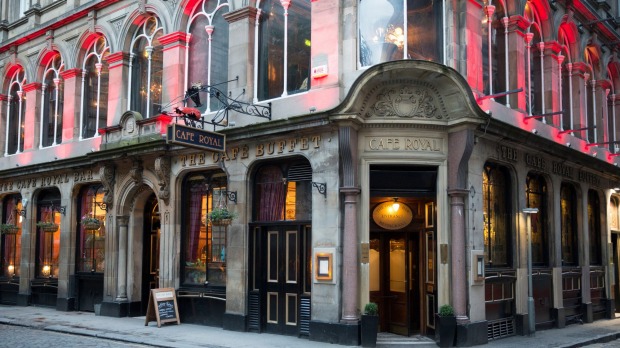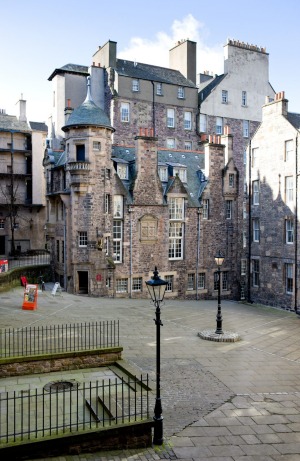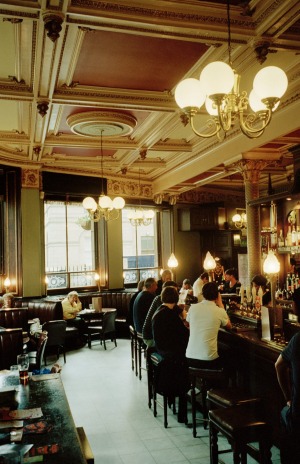
"There are no stars so lovely as Edinburgh street lamps."
On a paving slab at the top of the steps leading to the Makars' Court, one of the many hidey-holes tucked away behind Edinburgh's Royal Mile, these rather poignant words have been engraved.
They were written by a man who rose to fame in Edinburgh, shortly before he died in Samoa – about as far away from the Scottish capital as he could get. Robert Louis Stevenson isn't the only writer immortalised in the grey slabs of the secluded yard.

Walter Scott, Muriel Spark, James Boswell and John Buchan are amongst the other writers with strong Edinburgh links to have unknowingly contributed to the underfoot prose and poetry.
"The irony," says tour guide McBrain, pointing at the street lamp bearing down on Stevenson's quote, "is that they've only just got this working again. It was out for a couple of years."
McBrain and his colleague Clart lead a rather unusual traipse through Edinburgh's cultural heritage. The Edinburgh Literary Pub Tour strings together tales of key Edinburgh writers, stopping for a few drinks on the way.

It's part tour, part theatrical performance, and the two in-character guides have rather different interests. McBrain wants to take a rather academic approach – focusing, for example, on Robert Burns' influences and contributions to the resurrection of the Scots dialect in poetry. Clart is much more interested in the possibly tall stories of drinking, womanising and general misbehaviour.
In between, there's plenty of often baffling recital, where the cadence and earthy punchiness of the words more than make up for the dialect-driven incomprehensibility.
The tour starts in the Grassmarket, a long, rowdy place that once played home to public executions and now does an excellent line in public drunkenness. The initial venue is the Beehive Inn, where Burns would supposedly come to watch cockfights, but the walk continues up the seemingly ceaseless steps of the Old Town and into the much more structured New Town.
"Stevenson hated the New Town," we're told. Its carefully cultivated Georgian grandeur fitted one of his most famous characters, Dr Jekyll. The Old Town – haphazard, often dark, grimy and secretive – was a rather better match for his alter-ego, Mr Hyde.
The works and lives of Stevenson, Scott and Burns are explored in considerably more detail inside the Writers' Museum, which is tucked into the corner of Makar's court. But it turns out that Edinburgh's geographic duality didn't just appeal to the great writers of the past.
Inside the Café Royal, a glorious slice of the past with a massive wooden bar in the middle and ceramic art all over the walls, Ian Rankin happily sets into a beer. Rankin is the author of the Edinburgh-set Inspector Rebus crime novels, in which the city plays as big a part as the curmudgeonly detective.
Rankin says: "I started writing books about Edinburgh to make sense of Edinburgh, as I'm not from here originally. Edinburgh's the main character, and it's fascinating to explore her.
"Every city has that Jekyll and Hyde split, but in Edinburgh it's structurally there with the Old Town and New Town."
But Rankin also thinks Edinburgh has other advantages as a literary setting. "Edinburgh can seem containable. You're not dealing with LA or even London.
"It's very slippery, though. There's always something that happens that makes me think, 'I still don't know what makes this city tick.' It's still very complex."
That manageability makes Edinburgh not just a good place to set books, but to write them as well. "A lot of authors have moved here, such as JK Rowling, Kate Atkinson and Alexander McCall Smith," says Rankin. "They like the size."
Edinburgh has a population of around 500,000, which is the classic size for having all that's needed, while retaining a sense of community and human perspective. But its status as a capital and historical pedigree means it has a thoroughly disproportionate weight of cultural attractions.
Rankin points to the theatre scene as an example. "Theatre is still very strong here, with the Traverse and Lyceum being practically next door," he says. "The Lyceum is more traditional, while the Traverse goes more odd, different and weird. Sometimes it works and sometimes it doesn't."
But there are plenty of other, less obvious venues, too. Rankin points to Summerhall, once the home of the Royal School of Veterinary Studies, and now a discipline-spanning cultural hub. The calendar of events swings deliciously wildly – one day it can be a dance performance or folk gig, another a talk about science or a beer festival.
It's the role as a gathering place for the creative community that's arguably more important than the events list, however. There are studios and workshops inside, while the café and bar are buzzing hives of idea cross-pollination.
On the commendable stalwart side of the fence is The Stand. Edinburgh has a reputation for being the best place in the world for stand-up comedy during Festival season in August, then a laugh desert for the rest of it. This isn't a fair rep. A disproportionate number of comics choose to live in Edinburgh year-round, and The Stand has long carved out a reputation as one of the best comedy clubs in the country.
This is partly due to the quality of line-up it attracts, partly due to having something on every night, and partly due to its atmosphere. The venue is intimate, with a few small tables and no undue concern about being able to give everyone a seat. A lot of the time, it's standing room only at the back, and this stops it from falling into the "just another night out at the theatre" trap of many comedy venues. Consequently, it's a club that comedians absolutely adore playing at.
The final piece in the year-round cultural jigsaw comes in an exceptional museum collection. The likes of the National Museum of Scotland and National Gallery of Scotland are obvious big-hitters, but the creativity is often found in the temporary exhibitions at less heralded venues.
The City Art Centre near Waverley Station is a prime example of this. It has its own permanent collection, but regularly switches things up to show it in different ways and create thematic exhibitions.
Such commitment to keeping things fresh for locals is important in a city where so much is geared to visitors. It'd be easy to just do the festivals in August then become a cultural morgue for the rest of the year. But the festivals wouldn't be there in the first place without the cultural mindset embedded deeply in a city where even the paving slabs are poetic.
MORE INFORMATION
visitscotland.com
edinburghfestivalcity.com
GETTING THERE
Etihad launched a new route to Edinburgh in June. Flights from Sydney and Melbourne go via Etihad's Abu Dhabi hub. See etihad.com.
STAYING THERE
The sassy Malmaison in the former Sailor's Home in waterside suburb Leith has doubles from £65 ($136). See malmaison.com.
SEE + DO
The Edinburgh Arts Festival runs until August 30; the Edinburgh Festival Fringe and Edinburgh International Festival runs until August 31; see edinburghfestivalcity.com.
The Edinburgh Literary Pub Tour costs £12 ($26). See edinburghliterarypubtour.co.uk.
The Writer's Museum and City Art Centre. See edinburghmuseums.org.uk.
Summerhall. See summerhall.co.uk.
The Stand. See thestand.co.uk.
BOOK ACCOMMODATION WELL IN ADVANCE Finding somewhere to stay in August gets very pricey indeed, so advance scouting is required to secure good deals.
BE PREPARED TO EXPERIMENT Half of the fun comes in not knowing whether the unheard of comedian or avant garde theatre production is going to be any good. For every dud, there'll be a sparkler – it's worth taking the odd risk. The half price tickets sold in the hut next to the Royal Scottish Academy on the Mound are a good way of making sure this approach doesn't get too expensive.
LOCK IN THE TENT PEGS If there is something you really want to see, book it in advance, then fit the rest of the schedule around it. Bigger name performers and shows getting plenty of buzz usually sell out. Check the Fringe (edfringe.com) and Edinburgh Festivals (edinburghfestivals.co.uk) websites to see what's on, and the List (thelist.co.uk) or the Scotsman (scotsman.com) for reviews.
TAKE TIME OUT Charging from show to show for a few days soon gets exhausting – and very expensive. So get out of the Old Town's bedlam for a bit to decompress. Climbing Arthur's Seat, walking up Calton Hill or strolling the Water of Leith Walkway are excellent ways to escape the intensity.
PREPARE FOR RAIN Edinburgh's climate is rarely balmy and the person with a plastic poncho may look uncool, but they also look dry.